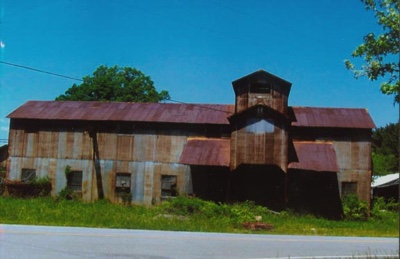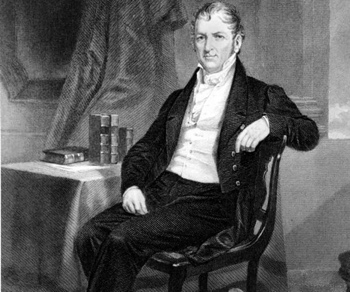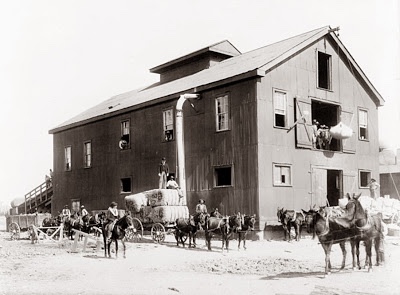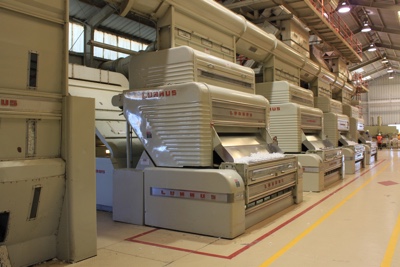When I was growing up in Fannin County in the 1950s and ’60s every community had one or two cotton gins. Most of them were abandoned, but there was still enough cotton in the area that some of them were still operational. When we would drive by one, my dad would say, “Have you boys ever seen how a gin works?” We would say no, and he would reply, “I got to take you to see a gin one day.”

We never got around to that adventure, and cotton production all but died out in the area, but about ten years ago, when I heard there was a gin still operating in Hunt County, I decided to take a road trip.
Update: The interview for this story was done in 2006, but a recent call to Myers Vittetoe confirmed that his is still cranking out the cotton bales. “Production was down a little last year, but this year is looking good right now,” he said. “There’s more cotton around here than I can remember.”
The increase in production has produced an increase in ginners, with Pat Pilgram’s PPF Gin and Warehouse opening recently in Delta County. “That new gin is brand new, state-of-the-art,” said Vittetoe. “He can do more faster than we can, but if the weather holds, I think the production will be so good this fall that there will be enough for everybody.”
I have heard from beekeepers, that cotton produces excellent honey. The rise in cotton production means more work for ginners and perhaps bees as well. Sounds good to me.
WOLFE CITY—In 1793 American planters harvested 100,080 pounds of cotton. In 1795 the figure jumped to 3,000,000 and by 1810 to 93,000,000. The blizzard of cotton came about because of Eli Whitney’s cotton gin.
Before Whitney, the only two cash crops in America were tobacco and indigo; cotton was akin to silk in its cost and rarity. The long-staple cotton that flourished along the southern seacoasts was difficult to grow, but it had slick, black seeds that could be separated from the lint, by hand, fairly easily, but slowly. Still a time and labor intensive process, it offered no real economic opportunities.
The upland south could grow short-staple cotton in abundance and at low cost, but the sticky seeds of that strain were all but impossible to separate from the fiber. One pound of cotton per day was all that could be expected from the slave labor that worked the southern plantations. Whitney’s gin, short for “engine,” increased that output by a factor of fifty.

Eli Whitney was a New England tinkerer. Early on he was fascinated by the mechanics of things—watches, clocks and small machines. At fourteen he started a nail making business and then went on to graduate from Yale in 1792. To pay off his debts, he took a job as a tutor on a Georgia plantation owned by Mrs. Catherine Greene, and at the suggestion of his employer, Whitney began looking for a way to mechanically separate lint from seed in short-staple cotton.
Legend has it that he got the idea for his invention from watching a cat take a swipe at a caged bird, and come away with only a paw full of feathers. Legend or fact, what Whitney came up with was a simple design—a spinning cylinder with wire teeth that pulled the cotton fibers through the narrow slits in a board, leaving the seeds behind.

In short time, the gin set cotton on the throne of American agriculture and provided the fabric for the industrial revolution by supplying the raw materials for the textile mills of the English midlands and the American northeast. For more than a century, across the American South, from Virginia to Texas, King Cotton reigned supreme.
***
Forty years ago cotton gins were everywhere. Most every town in North and East Texas had at least one gin, sometimes more, and in the fall, when it was picking time, the gin yards would be crowded with tall sided wagons filled to the top with cotton waiting to be ginned and baled. Working gins are few in number these days, and only a few rusty relics stand silent and abandoned to give evidence that this once was cotton country second to none.

The downturn in cotton farming in this part of Texas started in the 1960s, but recently cotton cultivation made a come back, and cotton production has been on the rise. “The farm bill changed. The cotton people had a better program. We had raised grain so much around here that we had a lot of grass build up and a lot of insect problems, so cotton made a good rotation crop,” said Jeff Vittetoe, who farms and helps run the gin owned by his father, Myers, in the Jacoby Community between Wolfe City and Greenville in Hunt County.
Last year [2005] the Vittetoe Gin produced four thousand bales from seven thousand acres of cotton under cultivation over several counties, but when Myers Vittetoe started raising cotton again on his Hunt County farm in the 1980s, he found that getting it ginned was a problem. He solved it by leasing an idle gin and putting it back into service. “The first year we just ginned our cotton,” said Jeff, “Then some other folks wanted a little bit ginned, and then some more, and it just sorta snowballed.”
Myers Vittetoe was leasing the old gin on a per bale basis, when he decided he would do well to upgrade the growing operation. In 1990, he bought the machinery in the old gin and relocated to the current site. “We bought an old building out of Gainesville,” said Jeff, “and built the gin out of old parts from the other gin and from old gins in West Texas.”
Some of the equipment dates back to the 1940s, but it still does the job, and while much of the ginning process has changed little over the years the cotton farming is far less labor intensive than in the past. Mechanized cotton strippers have replaced human pickers toting long sacks and pulling the fiber from the boles; the big machines make short work stripping the stalks in the field bare of their bounty.
Gone too, at least for the most part, are the tall sided cotton trailers. Vittetoe said he only unloaded cotton from four or five trailers all last year. In their place are big steel frames called modules. The eight by eight by thirty-two feet bottomless and topless frames are set down in a cotton field and loaded with the cotton from the strippers and then compacted. When the module is full—it will hold enough cotton to produce about 13, 488 pound bales—the compact “brick” of cotton is pushed out one end, and the module set down on another spot to be filled again.
Left behind is a great long compact brick of raw fiber. The brick is loaded onto a specially designed truck, whose bed tilts and, in effect, crawls under the cotton block and then transports it to the gin. Gone are the days when the farmer had to stop the harvest while waiting for the gin to empty his cotton trailers.
At the gin yard, the cotton blocks go onto a long concrete dock—at Vittetoe’s the dock will hold three of the thirty-two foot bricks—and a track mounted device moves slowly along the dock, chewing up the cotton bricks and sending the raw cotton, powered along by strong jets of air, into the gin. It takes only one man to operate the machine where it used to take four or five men to unload the cotton from the trailers. “Everybody wins from this,” said Vittetoe. “If the module has been sitting for a while, some of the cotton might be wet on the top or dirty on the bottom, but this feeder mixes it all together so the input to the gin is more even.”
The Vittetoe gin is a stand alone operation. A diesel generator provides the electricity to run those parts of the gin that need it, and an ancient, propane fired engine handles the rest. The equipment that does the actually ginning is belt driven. Long, twisted canvas belts reach out from a central shaft to transfer the power from the engine to the machinery. “We’re one of the few that still do it this way,” said Vittetoe. “Most gins use electric motors everywhere. But we’re better mechanics than we are electricians, and if something happens to this, we can fix it.”

In the gin house, the raw cotton is blown through a “thermo,” a machine that uses hot air to condition the lint. “The cotton relaxes when it gets hot, and that helps to release the trash and burrs. It also straightens out the lint. It’s sort of like ironing your shirt, and you can’t iron a shirt with a cold iron.” After the thermo, the lint goes though a series of devices that clean the refuse of leaves, stems, sticks and other detritus from the cotton. All this cotton is moved from one place to the other by air. It’s either on push side or the pull side, being blown or sucked into another machine. The trash that is removed goes to a collector out side.”
When the gin is running, the noise reverberates through the building with a Niagara-like roar, but in the spring, the gin house is quiet, and the sunlight poking through various cracks and dusty windows give the place an eerie look. Jeff Vittetoe’s voice echoes with a hollow reverb off the metal walls as he walks along explaining the processes that transform the rough cotton, straight from the fields, into a product ready for the mill.
When the cotton is cleaned, it goes into the gin proper. Vittetoe has two of these machines, and with a process not that far removed from what Eli Whitney devised more than two hundred years ago, the lint is grabbed by “saws” and pulled between narrow ribs. The seeds are too large to pass through the slots, so they work their way down and fall out into a collector.
“These things used to be real dangerous,” he said. “In the old days a lot of ginners were missing fingers, and some of them lost their lives in these things. But today, unless you do something really stupid you're pretty safe. You don’t have to get in there close to things to keep it running like you used to.”
After the seeds are removed, the cotton goes through one final cleaning. “It takes out stuff the size of black pepper and a lot of little immature seeds.” From there the lint goes into one of two press boxes. When the box is full—about five hundreed pounds of cotton—a hydraulic cylinder compresses the lint into a bale and wraps wires around it. “It’s real fast work. When they [the work crews] get together it’s sort of like a dance. Each one knows what the other one is fixing to do, and it’s really neat to watch those boys; they really know what they’re doing.”
Today, cotton is a lot like fruit and vegetables, it is carefully inspected and graded long before it reaches the market. Two samples are cut from each bale, with one of the samples going to a government test lab in Abilene, Texas and the other staying with the bale. The sample is graded and the bale tagged with the pertinent information which is tracked by computers.
And so what is left in the gin story? The refuse is collected and composted. The seed, most of it anyway, is sold for cattle feed. The bales of cotton from Vittetoe’s gin go to a broker in McKinney and are marketed by the Texas Independent Cotton Ginners Association. They pay the farmer the amount of the government loan on the cotton, and then, looking for the best prices, sell the product through out the year and remit a percentage of the profits to the producer.
Vittetoe’s cotton usually goes to a mill somewhere on the Pacific rim where it doubtless returns to the U.S.A. as tee-shirts with the slogan “I’m with stupid” silk screened on the front. And it’s all thanks to Eli Whitney and his cotton gin.